Equal But Different: The Transforming Power of Complementarity in the Relationship Between Men and Women. » książka
Equal But Different: The Transforming Power of Complementarity in the Relationship Between Men and Women.
ISBN-13: 9781932490350 / Angielski / Miękka / 2010 / 152 str.
Equal But Different: The Transforming Power of Complementarity in the Relationship Between Men and Women.
ISBN-13: 9781932490350 / Angielski / Miękka / 2010 / 152 str.
(netto: 64,67 VAT: 5%)
Najniższa cena z 30 dni: 67,71
ok. 16-18 dni roboczych
Dostawa w 2026 r.
Darmowa dostawa!
Throughout history, men and women during courtship have paid close attention to each other's beliefs and opinions. The reason for this is clear: the relationship could not possibly endure if there were serious disagreements about the "right" or "wrong" way to do things. Reaching the ideal form of companionship necessitates establishing a foundation of interlocking attributes upon which to build a marriage. Yet certain issues remain, such as how much should one press for similarity in viewpoint, how differences in outlook should be handled, and what level of difference should be considered too extreme. Equal but Different, by Paul Dennis Sporer, is an exceptional book that provides an original perspective on how we might comprehend a person's true nature through the interpretation of traits. Using analyses of historical events, census statistics, opinion polls, surveys, and studies, Sporer examines the devices that people use to cognize, match, and adjust patterns of opinions and attitudes. He finds that similarities between men and women in preferences and habits can smooth the path through courtship and into married life. However, it is essential to understand that differences can serve a vital function as well; "difference" is not fundamentally equivalent to "disagreement" or "dispute." Although perceptions of "difference" are to an extent derived from familial and cultural factors, prejudices can stand in the way of seeing how variations in personality can actually strengthen a relationship. The book investigates changes in interpretative concepts about personality attributes, where the traditional ideal of love has not been rejected, but instead has been "put on hold." A new, defective ideal has taken its place, one that incorporates self-centered motivations. Sporer finds that in the present generation, many men and women strongly prefer that the range of traits be "compressed" into simplistic conformity. He identifies the reasons why spouses are expected to be more similar to each other in personality. Indeed, a remarkable overlapping in temperament, background, and opinions in the "ideal" marriage partner is now required because fewer compromises have to be made; the perception is that less sacrifice means more independent behavior and thus higher social status. Innovative social methods are utilized to create a congruent and homogeneous set of traits, with higher level education being the most powerful and durable of these. Sporer also focuses on the difficulties that result from the "homogenizing" of relationships, such as increased competition between older and younger men for a younger woman's attentions. The book also explores the historic roots of these contemporary manifestations. In the early modern age, the fears engendered by interpersonal differences first led to various attempts to delay marriage, as well as an increase in unusual arrangements, such as marriage of first cousins. In fact, the changes in gender roles in the Nineteenth century can be largely attributed to efforts in homogenizing personality traits. Further effects included the modification of a range of beliefs about domestic life, such as reducing the size of the "ideal" number of children that a woman should have. We can see that the understanding of the most distinctive, intimate, and individualistic aspects of a person should be of critical importance in developing a long-lasting, viable relationship. Equal but Different gives us an enlightened new perspective on the inner meaning and value of personality traits, and how such attributes affect relations between the sexes. Although similarities in viewpoint and background can be strongly attractive from the beginning of a relationship, dissimilarities can open up rewarding new vistas that benefit both the man and woman.











